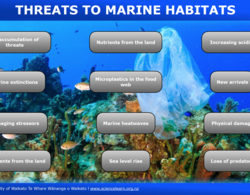
Extinction is the worst-case scenario when a species is facing threats, but it is also a threat in itself.
There are different types of extinction.
Global species extinction
This is the most widely known form of extinction when a species is completely gone from the planet – in other words, there are no surviving individuals (such as the moa or the Haast’s eagle). We classify threatened species based on how likely they are to become an extinct species. For example, fewer than 75 Māui dolphins exist. They are nationally critical and at a high risk of extinction.
Localised species extinction
Localised species extinction is when a species dies off in a specific area but is still present in other locations. For example, there are localised extinctions of bull kelp in New Zealand.
Functional species extinction
Functional extinction is when a species or habitat is found in such low numbers that they can’t fulfil their role in their ecosystem. Kōura (crayfish or rock lobster) can still be found at places in New Zealand, but in some areas such as the Hauraki Gulf, there are not enough breeding adults to maintain the population or play their important role as predators on shallow rock reefs.
Download the Department of Conservation infographic as a PDF.
Copyright: Department of Conservation


